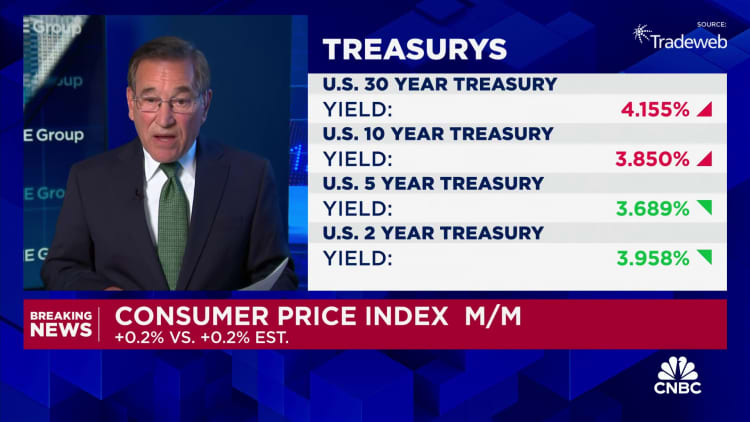Here is a breakdown of inflation for July 2024 – in one chart
d3 measure | A minute | Getty Images
Inflation continued to decline in July, helped by easing price pressures for food and energy and physical goods such as new and used cars.
The consumer price index, a key measure of inflation, rose 2.9 percent% in July from last year, the United States Department of Labor reported Wednesday. That number is down from 3% in June and the lowest number since March 2021.
The CPI measures how quickly prices change in the US economy. It rates everything from fruit and vegetables to haircuts, concert tickets and household appliances.
“I think it’s well into the strike zone,” Mark Zandi, Moody’s chief economist, said of the CPI report.
Perhaps most important to consumers is inflation for groceries “continues to grow very slowly,” Zandi said.
Combined with similar good news for other necessities like gas and market rents for new renters, “that’s very encouraging news, especially for low-income consumers who are the most oppressed,” he added.
Inflation guides the Fed’s interest rate policy
Inflation in July fell sharply from the pandemic peak of 9.1% in mid-2022, which was the highest level since 1981.
It is also close to policymakers’ long-term goal of around 2%.
“We think we’re at worst from an inflation perspective,” said Joe Seydl, senior economist at JP Morgan Private Bank.
The US Federal Reserve uses inflation data to help guide interest rate policy. It has raised prices to their highest levels in 23 years during the Covid-19 pandemic, raising the cost of borrowing for consumers and businesses in a bid to lower inflation.
The latest labor market data has alarmed some investors, who fear it will signal a US recession is imminent. Many economists say those concerns are widespread, at least for now.
However, lower inflation and a cooler labor market make it more likely that Fed officials will begin cutting interest rates at their next policy meeting in September, economists said. they said. Doing so will reduce the cost of borrowing, helping to boost the economy.
“In short, this CPI report represents a number of good points and adds to the evidence in support of a [0.25 percentage point] September rate cut,” Paul Ashworth, chief North American economist at Capital Economics, wrote in a note Wednesday.
Housing is an obstacle
Housing is the single biggest obstacle to keeping inflation above the Fed’s target for now — on paper, at least, economists said.
Shelter is the largest component of the CPI, and therefore has a large impact on inflation readings.
The housing index has risen 5.1% since July 2023, which is more than 70% of the annual increase in the “core” CPI, the BLS said Wednesday. (The core CPI is an economist-chosen measure of price levels. It excludes food and energy costs, which can change.)

After falling to 0.2% in June on a monthly basis, housing inflation returned to 0.4% in July, the BLS reported.
Housing prices rise and fall at a glacial pace because of the way the government measures them, economists said. Such data hides good news in the real-time rental market, which has seen its lowest price level in nearly two years, Zandi said.
More from Personal Finance:
59% of Americans mistakenly think the US is going bankrupt
401(k) rule rollover advice is at risk
Both Trump and Harris do not want a tax on tips
With the exception of the housing sector — which is likely to have reasonable grounds for moderation — “we’re the target of the Fed and later,” Zandi said.
“The mission is accomplished, in my view,” he said of the fight against inflation.
After excluding housing, the CPI rose 1.7% in July, below the Fed’s annual target.
Economists widely expect that CPI housing inflation will continue to moderate in line with current trends in the rental market.
Other ‘notable’ categories
Auto insurance, medical care, personal care and entertainment are other factors with “noticeable increases” over the past year, according to the BLS.
Prices in those categories increased by 18.6%, 3.2%, 3.4% and 1.4%, respectively.
The rise in new and used car prices over the past few years is likely to be driving up the cost of car insurance premiums and car repairs, as it is often more expensive to insure and to fix high-end cars, economists said.
They said insurance inflation must end along with falling car prices. Prices for new cars fell 1% last year, and used cars and trucks fell nearly 11%.
Egg prices – which had risen in 2022 due to the historic bird flu epidemic – are rising again following the re-emergence of the deadly disease. They are up 19% from last year.
Other food categories including bacon and crackers rose last year (by 8.5% and 3%, respectively), but their prices fell in July, suggesting a slowdown in more to come.
Average annual grocery prices were 1.1% in July, down from an average of 11.4% in 2022, which was the highest since 1979.
How supply and demand affect inflation
Material inflation rose as the US economy reopened in 2021. The Covid-19 pandemic disrupted supply chains, as Americans spent more on their households and less on services. such as dining and entertainment.
It’s a different story now. Depreciation of goods is very common, while the service sector is rare, economists said.
However, service inflation – generally more sensitive to labor costs – should slow further due to a weak labor market and slowing wage growth, economists said.
Higher interest rates have also worked to reduce overall inflation by reducing demand, Seydl said.
#breakdown #inflation #July #chart